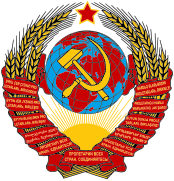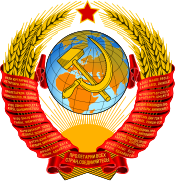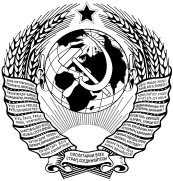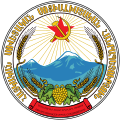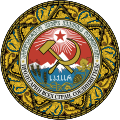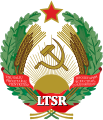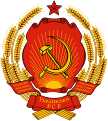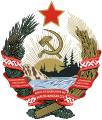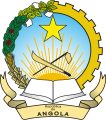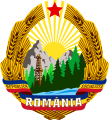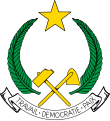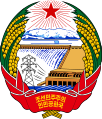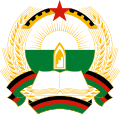Coat of arms of the Soviet Union
The shield of the Soviet Union corresponds to the national emblem used by said State from its establishment in 1922 until its dissolution in 1991. Throughout its history, the emblem had various modifications, but in general maintained the same structure since its adoption on July 6, 1923.
Although it is an emblem and not a coat of arms because, technically speaking, it does not respect heraldic norms, in Russian it has always been called герб, the word used for coats of arms traditional.
Description
The Constitution of the Soviet Union of 1936 described the national emblem of the USSR in its article 143: "The coat of arms of the Union of Soviet Socialist Republics consists of the hammer and sickle on the globe, illuminated by the rays of the sun and fringed with wheat ears, with the following inscription in the languages of the federated republics: "Proletarians of all countries, unite!" At the top of the shield there is a five-pointed star."
The shield is composed of the traditional Soviet symbols of the hammer and sickle on a globe, which is embraced by two sheaves of wheat surrounded by a red ribbon with the motto of the USSR, "Proletarians of all countries!" "Unite!", written in the fifteen languages of the Soviet Socialist Republics, in the reverse order to which they are cited in the Constitution of the USSR. Within the beams and under the globe appears a radiant sun, representative of the future, and above the set a five-pointed red star.
The version used in 1991 had the USSR motto in 15 languages, after in 1956, the Karelo-Finnish Soviet Socialist Republic was integrated into the Russian SFSR as Autonomous Soviet Socialist Republic.
Each of the coats of arms of the republics that made up the USSR had their own coats of arms, which were modifications of the national coat of arms. The coat of arms of the USSR also served as the basis for many other coats of arms of socialist states, such as the Socialist Federal Republic of Yugoslavia and the German Democratic Republic.
History
First version (1923-1936)
The shield project was accepted on July 6, 1923 at the second session of the Central Committee of the Communist Party of the Soviet Union and the version was completed on September 22 of that year.
This design was set in the Soviet Constitution of 1924:
"The emblem of the State of the USSR is composed of a sickle and a hammer in the world over the rays of the Sun and surrounded by wheat ears with the inscription Proletarians of all countries, unite! in six languages: Russian, Ukrainian, Belarusian, Georgian, Armenian and Tatar. At the top the emblem carries a five-point star."
Second version (1936-1946)
According to the Constitution of the Soviet Union of 1936, the USSR was made up of 11 republics, adding the Estonian, Latvian, Lithuanian, Moldovan and Finnish languages, with a total of eleven ribbons.
Third version (1946-1956)
The number of republics of the USSR became 16 shortly before the Great Patriotic War, but the Coat of Arms changed to reflect this only after the war. By a Decision of the Presidium of the Supreme Soviet of the USSR of June 26, 1946, the 16 constituent republics are represented in the Shield, having 16 ribbons with the motto in (in addition to the previous ones): Azeri, Turkmen, Uzbek, Tajik, Kazakh, Kyrgyz, updating due to the transfer from the Latin alphabet to the Cyrillic alphabet of the respective republics.
Fourth version (1956-1991)
In 1956 the Karelian-Finnish Soviet Socialist Republic was transformed into the Karelian Autonomous Soviet Socialist Republic, which was reflected in the coat of arms of the USSR. In a decision of the Presidium of the Supreme Soviet of the USSR of September 12 In 1956, the ribbon bearing the motto in Finnish was removed.
An even smaller change was introduced in the Belarusian motto by decision of the Presidium of the Supreme Soviet of the USSR, dated April 1, 1958.
First version of the Shield (1923–1936).
Second version of the Shield (1936–1946).
Third version of the Shield (1946–1956).
Fourth version of the Shield (1956–1991).
Version used in official documents.
Registrations
The inscriptions with the motto Proletarians of all countries, unite! in the latest version of the Shield are:
| Left | Centre | Right |
| Turcomano: !хли юртлары! пролетары, бирлеши!! | Estonian: Kõigi maade proletaarlased, ühinege! | |
| Tayiko: Пролетар!ои !амаи макат!о, як шавед! | Armenio: !ののののの。 A Armenian: !に。 !。 Armenio: !に。 !に。 | |
| Leton: Visu zemju proletārieši, savienojieties! | Kyrgyz:... | |
| Lithuanian: Visisi šalicie proletarai, vienykitės! | Moldavo: Пролетарь дин тоате цэриле, уници-вэ! | |
| Georgiano::の:。 Quoting。 !。 !。 !。 !。 !。 Georgiano::。 | Azerí: !т!н מл!рин пролетары, бирл!шин! | |
| Uzbeko: Bутун дунё пролетари, бирлашингиз! | Kazajo: BRарлыя елдерді! пролетарлары, бірігі!дер! | |
| Ukrainian: Пролетарі всіх країн, !днайтеся! | Russian: Пролетариии всех стран, соединятесь! | Belarus: Пралетарыіх краін, яднайцеся! |
Shields of the republics
Shield of the Armenian SSR
Shield of the Azerbaijan SSR
Shield of the Belarusian RSS
Escudo de la RSS de Estonia
Escudo de la RSS de Georgia
Shield of the SSR of Kazakhstan
Sculpture of the SSR of Kyrgyzstan
Shield of the Latvian RSS
Escudo de la RSS de Lithuania
Moldavia RSS shield
Shield of the Russian RSFS
Shield of the Tajik RSS
Escudo de la RSS de Turkmenistan
Escudo de la RSS de Ukraine
Uzbek RSS Feed
RSS Feed Carelo-Finesa (1940-1956)
Influence on other shields
The coat of arms of the Soviet Union has had an evident influence on the coats of arms of other socialist states that emerged later, or that received Soviet influence. Some of them are mentioned below:
Shield of the People ' s Republic of Albania (1946-1991)
Shield of the German Democratic Republic (1950-1990)
Escudo de Angola (1975)
Escudo de Mozambique (1975)
Shield of the People ' s Republic of Benin (1975-1990)
Emblem of the People ' s Republic of Bulgaria (1946-1990)
Emblem of the People ' s Republic of Hungary (1949-1990)
Emblem of the Socialist Republic of Romania (1948-1989)
National Assembly of the People ' s Republic of China (1949)
Shield of the People ' s Republic of the Congo (1970-1992)
Shield of the Socialist Federal Republic of Yugoslavia (1946-1991)
North Korea National Assembly (1948)
Vietnam National Assembly (1955)
Afghanistan National Assembly (1978-1992)
Contenido relacionado
Brazil's flag
Flag of bangladesh
Malaysian flag

